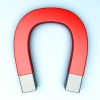Why Are Neodymium Magnets So Strong?
If you've ever handled a neodymium magnet, you know they don’t mess around. Even a small disc can snap onto a metal surface with surprising force, and they're not shy about pinching fingers along the way.
But why are neodymium magnets so strong? What gives them a powerful magnetic pull compared to magnets like ceramic or Alnico? This blog will explore the science behind these rare earth magnets, what makes them unique, and why they’re the top choice for high-performance applications.
What Is a Neodymium Magnet Made Of?
Neodymium magnets (also known as NdFeB magnets) are a type of rare earth magnet made from an alloy of three elements: neodymium, iron, and boron. This combination forms a hard, crystalline structure with the chemical formula Nd₂Fe₁₄B.
But it’s not just the ingredients that make them powerful—it’s how those atoms are arranged.
Inside every ferromagnetic material (like iron or neodymium) are microscopic regions called magnetic domains. When you expose the material to a magnetic field, those domains align in the same direction. The more aligned they are, the stronger the magnetic field they produce.
Neodymium magnets are particularly good at getting nearly all of their domains to align, bringing the material to what’s known as saturation magnetization. That means they store a lot of magnetic energy in a small space, and that’s exactly what gives them their unmatched pull strength.
High Saturation = High Strength
One reason neodymium magnets are so strong is their high saturation magnetization. This measures how much magnetic energy a material can hold, and neodymium magnets rank at the top.
At full saturation, a neodymium magnet creates a much stronger magnetic field than other types of permanent magnets. That’s why they can lift their weight several times, even when they’re no larger than a coin.
They Resist Demagnetization
Another reason neodymium magnets are so strong is coercivity, or how resistant a magnet is to becoming demagnetized.
Thanks to their atomic structure (which forms a tetragonal crystal lattice), neodymium magnets have what’s called high uniaxial magnetocrystalline anisotropy. In plain English? It means the magnet has one “easy axis” of magnetization that all the magnetic domains naturally want to align with. This makes it harder to knock the magnet out of alignment, even if it’s exposed to heat, vibration, or a competing magnetic field.
Neodymium Magnets vs. Other Types of Magnets
So, how do neodymium magnets compare to other permanent magnets?
Ceramic (Ferrite) Magnets
- Made from iron oxide and ceramic compounds
- Much weaker than neodymium, but inexpensive
- Common in refrigerator magnets, small motors, and craft projects
- Can break easily and aren’t ideal for high-performance tasks
- Heat resistant
Alnico Magnets
- Made from aluminum, nickel, and cobalt
- Stronger than ceramic but still weaker than neodymium
- Great for high-temperature environments
- Used in guitar pickups, sensors, and older motors
Samarium Cobalt (SmCo) Magnets
- Another type of rare earth magnet
- Nearly as strong as neodymium, with excellent heat resistance
- More expensive and brittle
- Used in aerospace, medical, and military applications
Why Neodymium Magnets Are the Top Choice
Neodymium magnets are the strongest type of permanent magnet available, making them ideal for:
- Motors and generators
- Headphones and speakers
- Magnetic tool holders and fixtures
- Hard drives and data storage
- Magnetic therapy and hobby projects
- Just about any application where size, weight, and strength matter
That said, neodymium magnets can be brittle and lose strength at very high temperatures, so it’s important to choose the right grade and coating for your specific project.
Shop Online and Follow Us to Learn More
We offer a vast selection of magnets, so be sure to browse through them to find the perfect options for your specific needs. Subscribe to our monthly newsletter! You’ll be among the first to receive notifications about our latest blogs and our latest magnet deals.
If you need further assistance or have questions, please don't hesitate to contact us.
Magnets can be dangerous. Neodymium magnets, especially, must be handled with care to avoid personal injury and damage to the magnets. Fingers and other body parts can get severely pinched between two attracting magnets. Bones can be broken by larger magnets.
Visit our Magnet Safety page to learn more.

